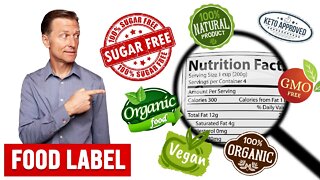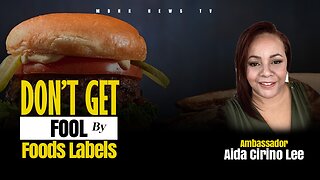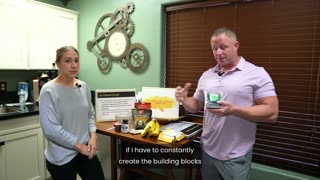5 Ways YOU Are Being Tricked with Misleading Food Labels
Manufacturers have interesting ways of tricking people when it comes to food labels. Learn more!
DATA:
https://pubmed.ncbi.nlm.nih.gov/30351215
https://www.menutail.com/blog/19/Is_Maltodextrin_Considered_An_Added_Sugar%3F
0:00 Introduction: How to read nutrition facts
0:28 Serving size
1:10 Trans fat
2:05 Carbohydrates
10:10 Whole grains
11:10 Keto-friendly products
12:40 Antibiotics
14:00 Check out my video on organic food!
Food packaging can be very misleading. Today we’re going to focus on how to read nutrition labels, so you can have more confidence in what you buy.
The most important things to look at on a food label:
1. Serving size
The different values are per serving size and not the whole container. You need to look at the serving size and how many servings are in the container. Then, you need to multiply how many servings you’re going to consume in one meal by the total net carbs.
2. Trans Fats
If the product contains less than 0.5 g, or 500 mg, of trans fats, the company can count it as zero. However, if either “hydrogenated” or “partially hydrogenated” is written somewhere in the ingredient list, you know there are trans fats in the product.
3. Carbohydrates
The net carbs are the total carbs with the total fiber subtracted. Your net carbs need to be below 50 g per day for keto. However, certain things like maltodextrin are listed under carbs instead of sugar—even though it acts like sugar. This means some products may be advertised as being low in sugar while they actually contain a lot of carbohydrates that act like sugar. Avoid any products with maltodextrin, dextrin, or resistant maltodextrin. Some sugar alcohols, including maltitol, sorbitol, and mannitol can spike your blood sugars and should also be avoided.
4. Whole grains
There are many things that can be added to whole grains, like sugars, chemicals, and preservatives. Whole grains also lose a lot of nutrients after being processed.
5. Keto-friendly products
Some keto-friendly products contain things you need to look out for, like wheat gluten, soy protein isolates, and beet sugar. 95% of beet sugar is GMO.
6. Antibiotics
When a product says something like “antibiotic-free.” That doesn’t mean there haven’t been antibiotics used. It means there haven’t been antibiotics used past the second day of life. If it’s classified as “no growth-promoting antibiotics” or “no medically important antibiotics,” they could have still used certain antibiotics.
ADD YOUR SUCCESS STORY HERE:
https://www.drberg.com/add-client-success-story?utm_source=youtube&utm_medium=description
FREE COURSE➜ ➜ http://bit.ly/BulletproofImmuneSystemCourse
Dr. Eric Berg DC Bio:
Dr. Berg, age 57, is a chiropractor who specializes in Healthy Ketosis & Intermittent Fasting. He is the author of the best-selling book The Healthy Keto Plan, and is the Director of Dr. Berg Nutritionals. He no longer practices, but focuses on health education through social media.
Follow Me On Social Media:
Facebook: https://bit.ly/FB-DrBerg
Instagram: https://bit.ly/IG-DrBerg
Anchor: https://bit.ly/Anchor-DrBerg
TikTok: https://bit.ly/TikTok-DrBerg
DR. BERG'S SHOP: http://shop.drberg.com/
Send a Message to his team: https://m.me/DrEricBerg
ABOUT DR. BERG: https://www.drberg.com/dr-eric-berg/bio
Disclaimer:
Dr. Eric Berg received his Doctor of Chiropractic degree from Palmer College of Chiropractic in 1988. His use of “doctor” or “Dr.” in relation to himself solely refers to that degree. Dr. Berg is a licensed chiropractor in Virginia, California, and Louisiana, but he no longer practices chiropractic in any state and does not see patients so he can focus on educating people as a full time activity, yet he maintains an active license. This video is for general informational purposes only. It should not be used to self-diagnose and it is not a substitute for a medical exam, cure, treatment, diagnosis, and prescription or recommendation. It does not create a doctor-patient relationship between Dr. Berg and you. You should not make any change in your health regimen or diet before first consulting a physician and obtaining a medical exam, diagnosis, and recommendation. Always seek the advice of a physician or other qualified health provider with any questions you may have regarding a medical condition.
#keto #ketodiet #weightloss #ketolifestyle
Thanks for watching! I hope this helps explain how to read a food label. I'll see you in the next video.
-
 14:15
14:15
Dr. Eric Berg
2 years ago5 Ways YOU Are Being Tricked with Misleading Food Labels
2081 -
 14:15
14:15
Dr. Eric Berg
2 years ago5 Ways YOU Are Being Tricked with Misleading Food Labels
196 -
 11:15
11:15
My NMN Experiment
2 years agoTesting shows DECEPTIVE LABELING on AMAZON SUPPLEMENTS 🤬
147 -
 7:52
7:52
Dr. Nick Zyrowski
5 months agoFake Foods You Eat Daily - Don't Be Fooled!
578 -
 5:49
5:49
DrNickZyrowski
4 years agoFood Combinations To Avoid | Choose Your Foods Wisely
17 -
 4:12
4:12
drtimharrigan
9 months agoLet's get real! CHEAP, or HARMFUL? Nutritional Formulas TRUTH
21 -
 4:47
4:47
Dr. Becky Fitness
1 year ago5 Surprising Foods with Hidden Sugar
2.06K9 -
 39:53
39:53
MAMLAKAK BROADCAST NETWORK
1 year agoDon’t get fool by food labels!!
8 -
 11:10
11:10
drtimharrigan
1 year agoPudding Magic! The #1 Health Hack! “We are what we eat is not accurate…"
103 -
 9:59
9:59
NaturesPathtoWellness
1 year agoAll The Ways SUGAR is HIDING in Your Food
98